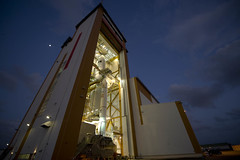
Image: Ariane 5 in the Bâtiment d’Assemblage Final (BAF) with ESA’s Herschel & Planck on board in May 2009
Last Sunday, 23 January, ESA’s Charlotte Beskow sent us another excellent update on ATV launch preparation activities. Charlotte, you’ll recall, is the ATV-2 Deputy Mission Manager and is working long days at Kourou together with team members from ESA and CNES.
Since it is a Sunday no one is supposed to be working; however, the office is crowded with busy people, who are studying procedures and making preparations for the final cargo load that takes place on 3 and 4 Feb. We have about 430 kg to load via an elevator as ATV will be on top of the launcher at that time.
I arrived in French Guyana on 19 January, after a nine-hour flight across the Atlantic. I drove straight to the Centre Spatial Guyanais (CSG) as fast as possible in order to get to the badging office before they closed. This is a nice place and launching is the only game in town so no one makes a fuss if you are a few minutes late. I got my badge plus some encouragement along the way, to “Go for it.” ATV has been sitting here (occupying a large part of the payload facilities) since May 2010. The fact that we could not launch in November had nothing to do with us. Now that all the other [satellite] clients have ‘gone up’, the road is clear for us and the CSG folks want to see off the rest of us as soon as possible.
The CSG people work very hard on these campaigns, often sacrificing evenings and Saturdays in order to satisfy the needs of the clients and resolve their never-ending list of urgent requests (e.g. A request made 21 January in the evening asked, “Can you find a calibrated mass of 20 tons by tomorrow?”). A normal campaign is only 4 to 8 weeks; this one has taken around 8 months.
I drove straight to the office and arrived in time to follow the convoy that would bring ATV from the payload integration facility (S5B) to the final integration hall (BAF), which is a few kilometres down the road.
The vessel is fully loaded with fuel contained in pressurised tanks, so this operation is hazardous. I was one of the two representatives of the client [ESA] to follow the convoy. We met at 19:00 at the entrance. During the day, ATV had been gently moved into a transport container. This container had been pushed out the door and into the specially designed vehicle, which has already served for other large ESA satellites, such as Envisat, XMM Newton, and Herschel and Planck. Their stickers were prominently displayed on the sliding door; to my regret, I noticed that there was no ATV sticker in sight.
The vehicle would lead, followed by safety representatives, clients (Astrium and myself), and the guys needed at the other end to move ATV into the BAF.
Since it was a dangerous operation, all participants were issued with rubber boots, overalls and a gas mask in case of a leakage incident. The overall look was far from encouraging; we could not make a positive fashion statement in these outfits! Considering that the temperature was around 30°C, I began to understand why this task was not the most popular.
As we waited, the vehicle gently moved out of the airlock, and the convoy began to move.
Usually when we drive around CSG, we just floor the accelerator. The road is straight, there are few crossings and traffic tends to be one-way. The daily routine is, usually: to the offices / launcher zone in the morning, back to town at lunch, to the offices at 14:00 and then back any time after 18:00.
This evening, the road was closed to all traffic (it is only a two-lane road and we needed both lanes) and we drove at a stately pace of 10-15 km/h. It took a while but that was the least of our worries.
Suddenly we realised that the road was not flat – it’s actually quite uneven, and there were 20 tons of sensitive hardware being moved. At one point we crossed the railway tracks that lead from the final assembly hall to the launcher zone, the vehicle inched gently over these. During the 45 minutes of transportation, ATV was in a perfectly controlled climate that was powered by compressors and monitored by all kinds of sensors.
Upon arrival, the teams unhooked the truck, and brought it round to the back. The doors slid up just enough to permit power and air cables to be passed out and connected (you do not want to bring a chugging diesel engine into a clean area) and, when all was ready, the doors to the airlock slid open, where ATV was pushed inside.
Work was over for the evening. It was close to 21:30 local time and we all headed off to the canteen for a bite to eat.
The following day, ATV was weighed and now the plan is to put it on top of Ariane on Monday, 24 January.
Once again a great update; Thank you Charlotte.

 Automated Transfer Vehicle page
Automated Transfer Vehicle page ATV blog archive
ATV blog archive
 NASA Orion page
NASA Orion page NASA Artemis
NASA Artemis Airbus Orion page
Airbus Orion page
Discussion: no comments